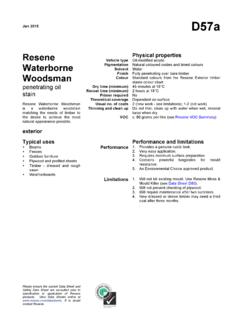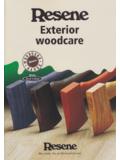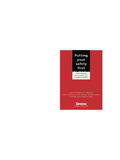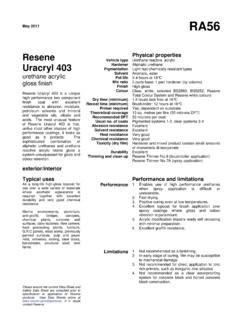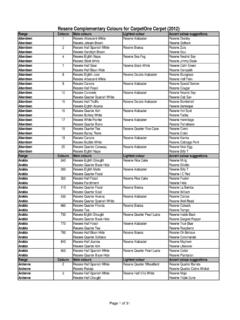Transcription of SIPDS No 3 Concrete and Cementitious Surfaces - …
1 March 2018 Page 1 Surface Information and Preparation Data Sheet ( SIPDS ) SIPDS No. 3 concrete and cementitious surfaces March 2018 Page 2 Contents Introduction .. 4 Substrate Information Notes .. 5 Note 1: 5 Note 2: Weather tightness responsibility .. 5 Note 3: Efflorescence .. 6 Note 4: Lime staining / leaching .. 7 Note 5: Windblown Salt (contamination) .. 8 Note 6: Drummy plaster .. 8 Note 7: Spalling Concrete / Concrete Cancer .. 8 Note 8: Clear finished Concrete , masonry and other Cementitious Surfaces .. 9 Note 9: Old Bituminous 10 Note 10: GRC Glass Reinforced Concrete .. 10 Note 11: Friable Cementitious Surfaces .. 11 Note 12: Spreading Rates .. 11 Note 13: Colour .. 11 Note 14: Curing / Drying of Paint waterborne Finishes .. 12 Note 15: Repaints .. 12 Note 16: Application Timeframe .. 14 Note 17: Form Oils and Release Agents .. 15 SURFACE SPECIFICATION 16 SECTION 1 Concrete Surfaces .. 17 Spec Sheet 3:1/1 - New Concrete Surfaces , including In-situ, Precast and Tilt Slab.
2 17 Spec Sheet 3:1A/1 - New Tilt Slab Polished / Aggregate rich .. 19 Spec Sheet 3:1C/1 - New Concrete Surfaces , including In-situ, Precast and Tilt Slab clear coat .. 20 Spec Sheet 3:1/2 - Weathered Concrete .. 21 Spec Sheet 3:1A/2 - Repair of Spalled, Drummy and Compromised Concrete and Plasters .. 22 Spec Sheet 3:1/3 - Previously Painted Concrete .. 23 SECTION 2 Masonry, Concrete Block .. 25 Spec Sheet 3:2/1 - New Masonry, Concrete Block, Brick .. 25 Spec Sheet 3:2C/1 - New Masonry, Concrete Block, Brick clear coat .. 26 Spec Sheet 3:2/2 - Weathered Unpainted Masonry / Block Surfaces .. 27 Spec Sheet 3:2/3 - Previously Painted Masonry / Block Surfaces .. 28 SECTION 3 Plaster and Rendered 29 March 2018 Page 3 Spec Sheet 3:3/1 - New Exterior Plaster and Rendered Finishes .. 29 Spec Sheet 3:3/2 - Weathered Plaster and Render .. 30 Spec Sheet 3:3/3 - Previously Painted Plaster and Render .. 31 SECTION 4 Fibre Cement Panels including Titan Board, Villaboard, Linea.
3 33 Spec Sheet 3:4/1 - New Fibre Cement Panels including Titan Board, Villaboard .. 33 Spec Sheet 3:4C/1 - New Fibre Cement Panels including Titan Board, Villaboard clear coat .. 35 Spec Sheet 3:4/2 - Weathered Fibre Cement Panels .. 36 Spec Sheet 3:4/3 - Previously Painted Fibre Cement Panels .. 37 Spec Sheet 3:4A/1 - New Linea Weatherboards and Fibre Cement Timber Substitutes .. 39 Spec Sheet 3:4A/3 - Re-painting Linea Weatherboards and Fibre Cement Timber Substitutes .. 40 Spec Sheet 3:4B/3 - Fibre Cement Cladding and Roofing containing ASBESTOS .. 42 SECTION 5 Exterior Concrete Decks, Patios and Porches .. 44 Spec Sheet 3:5/1 - New Exterior Concrete Decks Patios and Porches .. 44 Spec Sheet 3:5/2 - Weathered (unpainted) Exterior Concrete Decks Patios and Porches .. 46 Spec Sheet 3:5/3 - Previously Painted Exterior Concrete Decks Patios and Porches .. 48 Spec Sheet 3:5/4 Clear finished Concrete paving, pavers, driveways .. 49 SECTION 6 Interior Concrete Walls and Ceilings.
4 50 Spec Sheet 3:6/1 - New Interior Concrete Walls and Ceilings .. 50 Spec Sheet 3:6/2 - Old Unpainted Concrete Walls and Ceilings .. 52 Spec Sheet 3:6/3 - Previously Painted Concrete Walls and Ceilings .. 53 SECTION 7 Concrete Floors .. 55 Spec Sheet 3:7/1 - New Concrete Floors .. 55 Spec Sheet 3:7/2 - Old Unpainted Concrete Floors .. 57 Spec Sheet 3:7/3 - Previously Painted or Clear Finished Concrete Floors .. 59 Glossary .. 60 March 2018 Page 4 Introduction This SPIDS covers the preparation requirements as well as issues as they relate to the finishing of exterior and interior Concrete and Cementitious Surfaces for residential and commercial projects. New construction, the requirements for coating weathered and / or old Cementitious Surfaces and the repainting of existing Surfaces are covered in this SIPDS . It should be read in conjunction with the relevant standards: Concrete standard NZS 3114:1987; PPCS - Proprietary Plaster Cladding Standard; NZS :2007 - Solid Plastering and AS/NZS 2311:2009 Guide to the Painting of Buildings and the specification.
5 Relevant information on the substrate is covered in the Substrate Information Notes below. Where appropriate, additional information pertinent to the substrate preparation requirements is included with the specification. The preparation requirements for various Cementitious Surfaces are covered in the Surface Specification (Spec) Sheets, which are referenced by substrate type. If the issue encountered or the surface is not covered in this SIPDS ; if there is an inconsistency between documents or data sheets; or if you are unsure of the most appropriate and or best preparation methodology or paint system, please contact Resene Technical Services. March 2018 Page 5 Substrate Information Notes Note 1: Sealants The application and, where necessary, the reapplication of construction sealants is typically undertaken by a specialist contractor / applicator. Minor crack and gap filling (particularly when it is cosmetic as opposed to structural) is generally undertaken by the painter as part of preparing the surface for painting.
6 Construction Sealants are not designed to be painted over. In order to perform their primary function and retain long-term elasticity, they normally contain plasticisers. These can migrate through paint systems and discolour the surface and / or cause the surface to become tacky. As a result, dirt and other contaminants will not rain wash off and become difficult to clean. The sealant area can appear unsightly as a result. Provided flexible waterborne paint or coatings systems are used, this is a generally a cosmetic issue only and will not impact on the structural integrity of the sealant. If harder cross linking coatings are used (which retard the plasticiser migration), there is a risk the sealant will fail at the point where the coating cracks. This is referred to as a notch effect. Over time this can result in the failure of the sealant. Note 2: Weather tightness responsibility For new work or where painting or coating is required as part of a building renovation, the responsibility for ensuring that flashings, cappings and construction sealants have been correctly installed is the responsibility of the project s head contractor.
7 In repaint or recoating or where the contract requires the painting of older weathered Surfaces and is not part of a building renovation, the painting contractor should advise the building owner or owner s agent of any deficiencies or failings in the flashings, cappings and sealants that they become aware of. Unless otherwise required and detailed by the terms of the contract, any repairs and replacement of flashings, cappings and sealants will be considered outside the contract. It is expected, however, that the painting contractor would prepare and prime the substrate before painting if required. If deficiencies in the flashings, cappings sealants and general water tightness are suspected but the extent and location unknown, it is almost impossible to include when pricing a project and is typically tagged out by those tendering. A PC sum or agreed rate is usually included to cover this eventuality.
8 If this is not the case and the tender or spec covers old Cementitious Surfaces , a site instruction or note to tenderers should be included. If you are uncertain or require clarification, please contact Resene Technical Services. March 2018 Page 6 Note 3: Efflorescence Efflorescence is the term used to describe crystalline (or powdery) deposits, usually white in colour, that sometimes form on the surface of brickwork, Concrete plasters and other Concrete type structures. The photos below are examples of efflorescence on a painted surface (Ref 1) and on masonry (Ref 2). Where a clear coating system is applied to the block, the efflorescence would be more noticeable. It is also almost impossible to remove without removing the clear finish, treating and reapplication of the entire system. Ref 1 Ref 2 In most cases, efflorescence is the result of calcium hydroxide (lime) from Cementitious substrates being carried to the surface by water.
9 This then reacts with carbon dioxide in the air to form insoluble calcium carbonate. Normally efflorescence is only of cosmetic concern although it can ruin the appearance and physically damage paint coatings. See Ref 1 above. Longer term efflorescence is most often the result of uncontrolled moisture movement caused initially by poor design details and poor construction techniques. Before attempting to remove efflorescence, the source of moisture getting into the substrate should be eliminated. Ensure: Joints and cavities are properly sealed. Rainwater run-off is diverted to suitable drainage. Physical barriers are in place between brickwork and in situ Concrete . Tops of parapets have cappings and windows and doors have suitable flashings in place. Cavities are well-ventilated. Vapour barriers are used to stop uptake of groundwater. Efflorescence can be removed by physically scrubbing with a stiff brush and careful washing.
10 Water blasting may result in a continuation of the efflorescence as more water may be blasted into the substrate. March 2018 Page 7 Where a clear coating such as Resene XC-700 is specified, efflorescence control techniques must be affected to prevent the accumulation of salts behind the coating system. Failure to do so will see the gradual development of white areas underneath the coating in areas where efflorescence is accumulating. Note 4: Lime staining / leaching As noted above, lime staining or leaching is similar to efflorescence and is treated in the same manner when painting. The picture below (Ref 3) is an example of lime leachate on an unpainted plaster surface, whilst Ref 4 shows the same onto a painted surface. Concrete is the complex reaction product of aggregates, silica sand and calcium silicates present in cement. Lime is produced during the setting reaction that slowly further reacts with the silica sand to form more cement.
